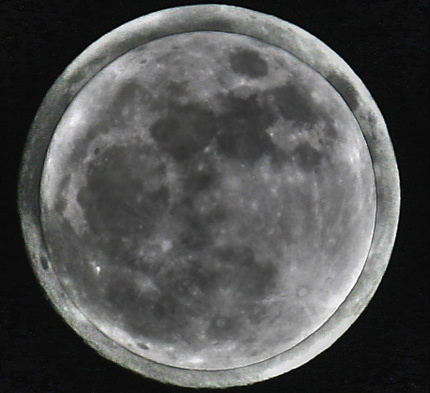July 12 full moon first of 3 full-moon supermoons in 2014

Tonight July 12, 2014
Courtesy U.S. Naval Observatory
.
The moon has reached the crest of its full phase. The full moon crested this morning (July 12, 2014) at 6:25 a.m. CDT. (11:25 UTC). Saturday night’s moon will still look full, however, and it’ll be closest to Earth for this month. The moon’s perigee or closest point comes at at 3:37 a.m. CDT (8:27 UTC) Sunday morning, July 13. For all of us, around the world, the moon on both Friday and Saturday night rise around the time of sunset and set at dawn.
.
Thus on July 12 we have the first full moon after the June 21 solstice. Around this time of year, in North America, buck deer start growing antlers, thunder storms rage and farmers struggle to pile up hay in their barns. Thus, according to folklore, we call this full moon the Buck Moon, Thunder Moon or Hay Moon. The July 2014 full moon is also the first of three full-moon supermoons in 2014. Previously, we had two supermoons in January – on January 1 and 30 – but they were new-moon supermoons. The full moons on July 12, August 10 and September 9 all enjoy the supermoon designation because the centers of these full moons and the center of Earth are less than 361,863 kilometers (224,851 miles) apart. The closest supermoon of the year comes with the August 10 full moon, presenting a moon that’s only 356,896 kilometers (221,765 miles) from Earth.
Because it’s a supermoon, and relatively close to Earth, expect higher-than-usual tides in the days ahead.
What is a supermoon?
When exactly is the July full moon?
The full moon mirrors sun’s path for six months hence
When exactly is the July full moon?
The full moon mirrors sun’s path for six months hence

Despite
the moon-drenched skies, you should be able to make out the planets
Saturn and Mars, plus the star Spica, in the southwest sky on these
July evenings. Use the Big Dipper to locate Spica and Mars tonight!
Clock time for this full moon – and every full moon – varies by time zone. For London, the moon turns full at 12:25 p.m. BST in the afternoon on July 12, at which time the moon is below their horizon and shining on the nighttime side of the world. For the U.S. West Coast, the moon turns full on at 4:25 a.m. PDT on July 12, where the full moon sits low in the west just before sunrise.
Technically speaking, the moon turns full at the instant that the moon lies most opposite the sun for the month. Because the moon stays more or less opposite the sun throughout the night, watch for a full-looking moon in the east at dusk, highest in the sky around midnight and low in the west at dawn. On the nights around the night of full moon, the moon looks full for a few nights.
Day and night sides of Earth at instant of July full moon
 |
| Day and night sides of Earth at the instant of the July 2014 full moon (2014 July 12 at 11:25 Universal Time) |
Day and night sides of Earth at the instant of the July 2014 full moon (2014 July 12 at 11:25 Universal Time)
.
Bottom line: The full moon on July 12 ushers in the first of three full-moon supermoons in 2014. Full moon is July 12, 2014 at 6:25 a.m. CDT. (11:25 UTC). The moon’s perigee or closest point comes at at 3:37 a.m. (8:27 UTC) Sunday morning, July 13.


No comments:
Post a Comment